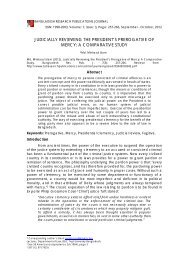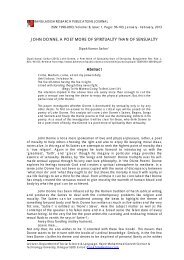agricultural growth and agricultural credit in the context of bangladesh
agricultural growth and agricultural credit in the context of bangladesh
agricultural growth and agricultural credit in the context of bangladesh
You also want an ePaper? Increase the reach of your titles
YUMPU automatically turns print PDFs into web optimized ePapers that Google loves.
Sharmeen <strong>and</strong> Chowdhuryaround 63% & 37% <strong>of</strong> <strong>the</strong> enlisted banks’ <strong>credit</strong> lend<strong>in</strong>g (Rahman et al., 2011) has beendirected towards help<strong>in</strong>g <strong>the</strong> agro-based community develop through short-term & longtermloans, respectively. It can be mentioned here, that current-<strong>credit</strong> schemes are mostlyfound to help farmers & growers with certa<strong>in</strong> season-based <strong>agricultural</strong> production;whereas, non-current <strong>credit</strong> options aid <strong>the</strong> producers with deploy<strong>in</strong>g hi-tech mach<strong>in</strong>eries,sett<strong>in</strong>g-up <strong>agricultural</strong> <strong>in</strong>dustries or factories, <strong>in</strong>stall<strong>in</strong>g varied irrigation tools etc., that canboost-up <strong>the</strong> production <strong>of</strong> <strong>the</strong> crops & help <strong>in</strong> shift<strong>in</strong>g <strong>the</strong> production scale positively. In atraditional circumference, <strong>the</strong> farmers were familiarized with cultivat<strong>in</strong>g crops on l<strong>and</strong>taken-<strong>in</strong> from <strong>the</strong> affluent l<strong>and</strong>-lords <strong>of</strong> <strong>the</strong> village. Months <strong>of</strong> rigorous effort, went-<strong>in</strong> firstly,by plough<strong>in</strong>g <strong>and</strong> mak<strong>in</strong>g <strong>the</strong> l<strong>and</strong> suitable for cultivation manually, sow<strong>in</strong>g seeds <strong>and</strong>f<strong>in</strong>ally with <strong>the</strong> appearance <strong>of</strong> bounty crops, shar<strong>in</strong>g significant portion <strong>of</strong> it, with <strong>the</strong> l<strong>and</strong>lordas payment <strong>of</strong> lease, or ‘khajnaa’. Though, this approach did survive for an epic-time,<strong>and</strong> is still prevail<strong>in</strong>g, <strong>in</strong> <strong>the</strong> <strong>context</strong> <strong>of</strong> Bangladesh <strong>and</strong> <strong>the</strong> Indian Sub-cont<strong>in</strong>ent, so tospeak, <strong>the</strong> opportunity cost <strong>of</strong> it, deprived <strong>the</strong> potentially <strong>in</strong>dependent growers <strong>of</strong>economic-freedom. This f<strong>in</strong>ancial- autonomy comes <strong>in</strong> stages start<strong>in</strong>g from <strong>the</strong> ability tobuy electronic gadgets, tools <strong>and</strong> mach<strong>in</strong>eries to speed up grow<strong>in</strong>g process <strong>of</strong> crops <strong>and</strong>probable option <strong>of</strong> not hav<strong>in</strong>g paid <strong>the</strong> khajnaa anymore. Therefore, <strong>the</strong> result <strong>of</strong> <strong>the</strong><strong>in</strong>fluence <strong>and</strong> effectiveness <strong>of</strong> <strong>credit</strong>-options <strong>in</strong> <strong>agricultural</strong> <strong>growth</strong> is irrefutable.The small-scale farmers <strong>and</strong> <strong>the</strong> countryside poor are <strong>of</strong>ten to decide between tak<strong>in</strong>gmonetary assistance from ei<strong>the</strong>r social or <strong>in</strong>stitutional sources. The social source may<strong>in</strong>clude friends, family members, shop owners, agents etc, whereas, <strong>the</strong> <strong>in</strong>stitutional sourcehas banks, micro f<strong>in</strong>ance <strong>in</strong>stitutions <strong>and</strong> o<strong>the</strong>r f<strong>in</strong>anc<strong>in</strong>g organizations (Bashir et al., 2010;Okojie et al., 2010). Faruqee (2010), <strong>in</strong> his work<strong>in</strong>g paper, has identified three majorsources <strong>of</strong> <strong>of</strong>ficial loan providers <strong>in</strong> <strong>the</strong> rural <strong>context</strong> <strong>of</strong> Bangladesh. They are <strong>the</strong> “formal,<strong>in</strong>formal <strong>and</strong> <strong>the</strong> quasi-formal” sources <strong>of</strong> fund providers. As cited <strong>in</strong> <strong>the</strong> paper, <strong>the</strong> friends,relatives <strong>and</strong> family fall <strong>in</strong> <strong>the</strong> category <strong>of</strong> <strong>in</strong>formal loan providers, <strong>and</strong> result to asignificant 8% - 21% <strong>of</strong> rural people seek<strong>in</strong>g fund from this. Interest<strong>in</strong>gly, <strong>the</strong> loanrepayment record also happens to be satisfactory from this source (Faruqee, 2010). Thismay be due to <strong>the</strong> terms <strong>of</strong> <strong>the</strong> f<strong>in</strong>ance be<strong>in</strong>g straight-forward <strong>and</strong> underst<strong>and</strong>able, <strong>in</strong>comparison to <strong>the</strong> twisted conditions l<strong>in</strong>ked by a formal f<strong>in</strong>anc<strong>in</strong>g organization. Researchwhereas, also discovered a moderate 16% <strong>of</strong> <strong>the</strong> cultivators gett<strong>in</strong>g <strong>credit</strong> from formalsources like banks (Faruqee, 2010). Thus, <strong>the</strong> terms <strong>and</strong> conditions <strong>and</strong> <strong>in</strong>stitutionalprocedures need to be simplified (Saboor et al., 2009). As most <strong>of</strong> <strong>the</strong> growers have lessereducation rate or may be uneducated, <strong>the</strong>ir ability to underst<strong>and</strong> <strong>the</strong> twists <strong>and</strong> turns <strong>of</strong>loan-schemes may always not be possible. This might result <strong>in</strong>to a cyclic action <strong>of</strong> <strong>credit</strong>default; failure to atta<strong>in</strong> monetary assistance from various <strong>in</strong>stitutions at a later period <strong>and</strong>loos<strong>in</strong>g <strong>the</strong> on-go<strong>in</strong>g production facility.When it comes to f<strong>in</strong>anc<strong>in</strong>g tools, <strong>the</strong>re is also a variety <strong>in</strong> options that are available to <strong>the</strong>growers. Several former researches have suggested a various mix <strong>of</strong> easy <strong>credit</strong> plans thatcan aid <strong>the</strong> new farmers, beg<strong>in</strong>ners or small-scale <strong>agricultural</strong> entrepreneurs to start-upproduction on <strong>the</strong>ir own (Saboor et al., 2009). If it is availed to <strong>the</strong> small-scale farmers,with lesser overhead costs, it can motivate many unemployed farmers or growers to geton board as well. Never<strong>the</strong>less, several studies (Badiru, 2010; CDF, 2006 as cited <strong>in</strong>Rahman et al., 2011; Rahman, 2004; Gloy et al., 2005) have shown a common practicethat, both <strong>the</strong> availability <strong>and</strong> accessibility <strong>of</strong> f<strong>in</strong>ance is more <strong>in</strong> NongovernmentalOrganizations-Micr<strong>of</strong><strong>in</strong>ance Institutions (NGO-MFIs) due to higher presence <strong>of</strong> branches <strong>of</strong><strong>the</strong> same <strong>in</strong> village-levels, <strong>in</strong> contrast to ma<strong>in</strong>stream Commercial Banks, which onlyoperate <strong>in</strong> Metropolitan locations. General loans, program loans, hous<strong>in</strong>g loans etc. arefew <strong>of</strong> <strong>the</strong> popular loan products issued by f<strong>in</strong>ancial <strong>in</strong>stitutions like <strong>the</strong> MFI’s <strong>in</strong>Bangladesh’s rural sector (Faruqee, 2010). In his work<strong>in</strong>g paper, Faruqee (2010) hasidentified, <strong>agricultural</strong> activities, operat<strong>in</strong>g poultry, livestock, sericulture, fisheries <strong>and</strong>forestry are <strong>the</strong> major deeds that are covered <strong>in</strong> <strong>the</strong> program loans issued by <strong>the</strong> NGOs-MFIs. However, <strong>the</strong> down-fold <strong>of</strong> this system, is <strong>the</strong> sheer amount <strong>of</strong> added <strong>in</strong>terest that isbe<strong>in</strong>g charged to <strong>the</strong> farmers, <strong>in</strong> oppose to <strong>the</strong> Commercial <strong>and</strong> Private Banks.On <strong>the</strong> contrary, <strong>the</strong> NGO-MFIs make <strong>the</strong> option <strong>of</strong> f<strong>in</strong>anc<strong>in</strong>g easier to <strong>the</strong> small-scalefarmers, by eradicat<strong>in</strong>g pre-condition <strong>of</strong> f<strong>in</strong>ancial security or guarantee, for f<strong>in</strong>ance. As aconsequence, <strong>the</strong> repayment <strong>of</strong> <strong>the</strong> loan <strong>in</strong>volves higher <strong>in</strong>terest rates (Badiru, 2010;Rahman et al., 2011; Okojie et al., 2010; Gloy et al., 2005). Therefore, <strong>the</strong> farmers face achoice for opt<strong>in</strong>g between an accessible f<strong>in</strong>anc<strong>in</strong>g option that is costly; or, avail<strong>in</strong>g a lesshttp://www.bdresearchpublications.com/journal/176
















